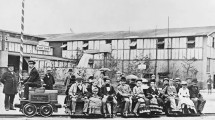Abstract
Most parallel hybrid tractors are conceptualized as a motor which serves as an auxiliary power source that handles loads which an engine does not cover. However, the development of hybrid tractors for better traction performance does not show greatly improved fuel consumption compared to conventional tractors, meaning that different means of controlling- the power source is needed for hybrid tractors. In this study, improving fuel consumption in a parallel hybrid tractor is demonstrated through power split ratio strategy after devising a simulation model of a power train. Initially, the simulation of the power train in a parallel hybrid tractor needs to assess the following actual traction performance factors: the engine, the wheels, and the PTO speed. PTO is the abbreviation of Power Take Off, which is any of several methods for taking power from a power source. Rule-based power distribution strategy depending on the optimal control then changes fuel savings while working over wide land areas. Finally, vehicle performance values which include certain operating points and fuel consumption between a case of the hybrid and a case of control of the traction power source for traction improvement are compared and analysed.
Similar content being viewed by others
Abbreviations
- M :
-
Vehicle mass (kg)
- g :
-
Gravity (m/s^2)
- θ :
-
Incline (%)
- ρ air :
-
Air density (kg/m^3)
- C d :
-
Coefficient of air resistance
- A f :
-
Frontal area (m^2)
- V :
-
Vehicle velocity (m/s^2)
- f r :
-
Coefficient of rolling resistance
- T eng :
-
Engine torque (Nm)
- T mot :
-
Motor torque (Nm)
- F mg :
-
Wheel resistance of Incline (N)
- F aero :
-
Wheel resistance of air (N)
- F fr :
-
Wheel resistance of ground (N)
- I g :
-
Transmission gear
- r f :
-
Final ratio
- r t :
-
Tire radius (m)
- ω eng :
-
Engine speed (rpm)
- ω mot :
-
Motor speed (rpm)
- ω target :
-
Engine target speed (rpm)
- T req :
-
Required torque of vehicle (Nm)
- F t :
-
Vehicle wheel load (N)
- I veh :
-
Inertia of the vehicle (kg m^2)
References
Ehsani, M., Gao, Y. M., and Emadi, A., “Modern Electric, Hybrid Electric, and Fuel Cell Vehicles: Fundamentals, Theory, and Design,” CRC Press, 2nd Ed., pp. 459–469, 2010.
Jeong, J., Lee, D., Shin, C., Jeong, D., Min, K., et al.,“Comparison of the Fuel Economy of Series and Parallel Hybrid Bus System Using Dynamic Programming,” The Korean Society of Automotive Engineers, Vol. 21, No. 1, pp. 92–98, 2013.
Tritschler, P., Bacha, S., Rullière, E., and Husson, G., “Energy Management Strategies for an Embedded Fuel Cell System on Agricultural Vehicles,” Proc. of International Conference on Electrical Machine, pp. 1–6, 2010.
Zheng, C., Cha, S. W., Park, Y.-I., Lim, W. S., and Xu, G., “PMPBased Power Management Strategy of Fuel Cell Hybrid Vehicles Considering Multi-Objective Optimization,” Int. J. Precis. Eng. Manuf., Vol. 14, No. 5, pp. 845–853, 2013.
Hofman, T., Steinbuch, M., Van Druten, R., and Serrarens, A., “Rule-Based Energy Management Strategies for Hybrid Vehicles,” International Journal of Electric and Hybrid Vehicles, Vol. 1, No.1, pp. 71–94, 2007.
Kessels, J. T., Koot, M. W., Van Den Bosch, P. P., and Kok, D. B., “Online Energy Management for Hybrid Electric Vehicles,” IEEE Transactions on Vehicular Technology, Vol. 57, No. 6, pp. 3428–3440, 2008.
Jeong, J., Lee, D., Kim, N., Park, Y.-I., and Cha, S. W., “Fuel Economy Analysis of a Parallel Hybrid Bus Using the Optimal Control Theory,” Proc. of IEEE Vehicle Power and Propulsion, pp. 1–5, 2011.
Zheng, C. H., Park, Y. I., Lim, W. S., and Cha, S. W., “Fuel Economy Evaluation of Fuel Cell Hybrid Vehicles Based on Optimal Control,” International Journal of Automotive Technology, Vol. 13, No. 3, pp. 517–522, 2012.
Kim, N. W., “Energy Management Strategy for Hybrid Electric Vehicles Based on Pontryagin’s Minimum Principle,” Ph.D. Thesis, Department of Mechanical Aerospace Engineering, Seoul National University, 2009.
Bernard, J., Delprat, S., Büechi, F. N., and Guerra, T. M., “Fuel-Cell Hybrid Powertrain: Toward Minimization of Hydrogen Consumption,” Transactions of IEEE Vehicular Technology, Vol. 58, No. 7, pp. 3168–3176, 2009.
Author information
Authors and Affiliations
Corresponding author
Rights and permissions
About this article
Cite this article
Lee, HS., Kim, JS., Park, YI. et al. Rule-based power distribution in the power train of a parallel hybrid tractor for fuel savings. Int. J. of Precis. Eng. and Manuf.-Green Tech. 3, 231–237 (2016). https://doi.org/10.1007/s40684-016-0030-6
Received:
Revised:
Accepted:
Published:
Issue Date:
DOI: https://doi.org/10.1007/s40684-016-0030-6




